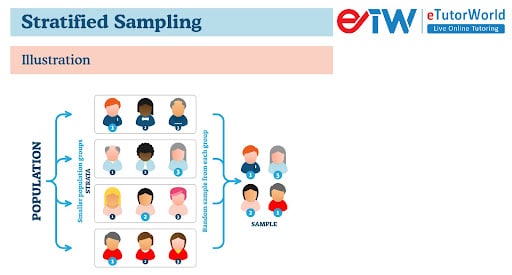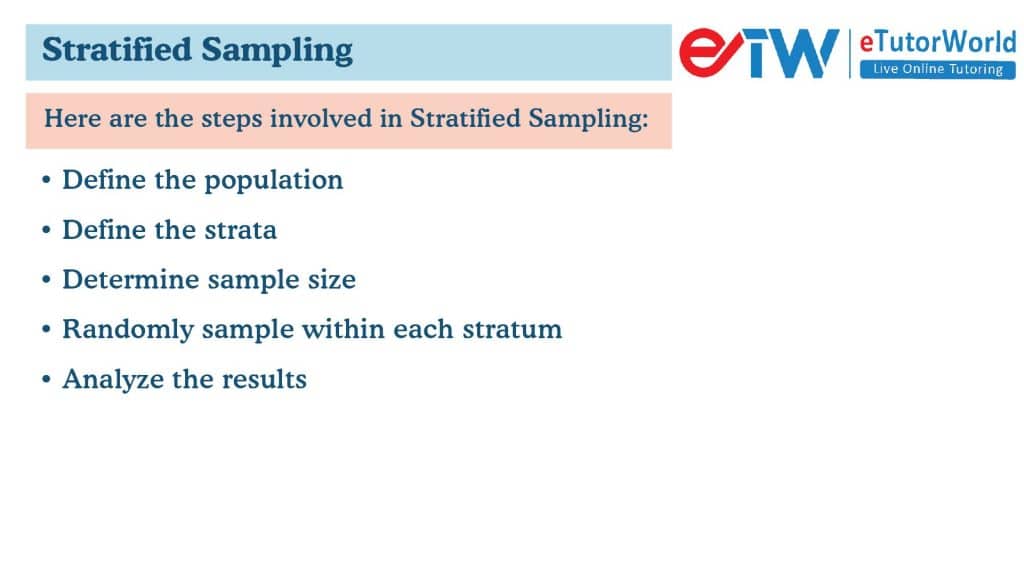Stratified Sampling
Grade 7 Math Worksheets
Stratified sampling is a probability sampling technique that involves dividing a population into subgroups, or strata, based on some characteristic of interest (such as age, gender, income level, or education level) and then randomly selecting samples from each stratum.
Table of Contents:
- Stratified Sampling
- Methods of Stratified Sampling
- Advantages of Stratified Sampling
- Disadvantages of Stratified Sampling
- FAQs
Personalized Online Tutoring
Stratified Sampling - Grade 7 Math Worksheet PDF
This is a free worksheet with practice problems and answers. You can also work on it online.
Sign up with your email ID to access this free worksheet.
"We really love eTutorWorld!"
"We really love etutorworld!. Anand S and Pooja are excellent math teachers and are quick to respond with requests to tutor on any math topic!" - Kieran Y (via TrustSpot.io)
"My daughter gets distracted easily"
"My daughter gets distracted very easily and Ms. Medini and other teachers were patient with her and redirected her back to the courses.
With the help of Etutorworld, my daughter has been now selected in the Gifted and Talented Program for the school district"
- Nivea Sharma (via TrustSpot.io)
Stratified Sampling
Stratified sampling is a probability sampling technique that involves dividing a population into subgroups, or strata, based on some characteristic of interest (such as age, gender, income level, or education level) and then randomly selecting samples from each stratum.
The main goal of stratified sampling is to ensure that the sample is representative of the population by making sure that each subgroup is properly represented in the sample.
Here are the steps involved in stratified sampling:
Define the population: Identify the population of interest and determine the characteristic(s) that will be used to create strata.
Define the strata: Divide the population into mutually exclusive strata based on the characteristic(s) of interest. Each member of the population should belong to one and only one stratum.
Determine sample size: Determine the sample size for each stratum based on the proportion of the population in each stratum. Larger strata will generally require larger sample sizes.
Randomly sample within each stratum: Randomly select members from each stratum using a sampling technique such as simple random sampling or systematic sampling.
Analyze the results: Analyze the data collected from the sample to make inferences about the population.
Some advantages of stratified sampling include:
- It ensures that each subgroup is properly represented in the sample, which can lead to more accurate results.
- It allows researchers to examine the characteristics of different subgroups within the population.
- It can help to reduce sampling error by ensuring that the sample is representative of the population.
However, some potential disadvantages of stratified sampling include:
- It can be more complex and time-consuming than other sampling techniques.
- It requires knowledge of the population in order to properly define and create strata.
- It can be more expensive to implement than other sampling techniques, especially if the population is highly diverse and requires many strata to be defined.
Methods of Stratified Sampling
There are different methods of stratified sampling, including:
Proportional stratified sampling: This method involves selecting a sample size from each stratum based on the proportion of that stratum in the overall population. For example, if a population is divided into two strata, with 40% in stratum A and 60% in stratum B, then a sample of 40% of the total sample size should be taken from stratum A, and a sample of 60% should be taken from stratum B.
Disproportional stratified sampling: This method involves selecting a different sample size from each stratum, based on the desired level of precision or importance of the stratum. For example, if a certain stratum is expected to have high variability, it may require a larger sample size to ensure sufficient precision.
Optimal allocation stratified sampling: This method involves selecting sample sizes from each stratum based on the variability and size of the stratum, in order to minimize the variance of the estimator of the population parameter. It involves a mathematical calculation to determine the optimal sample size allocation for each stratum.
Clustered stratified sampling: This method involves selecting clusters of subjects within each stratum, rather than individual subjects, and then randomly sampling subjects within each selected cluster. This method can be useful when individual subjects within a stratum are difficult to identify or access, but clusters are readily available.
The choice of method depends on the nature of the population and the research question. Proportional stratified sampling is the most commonly used method and is appropriate when strata are roughly similar in size and variability.
Optimal allocation is more appropriate when strata differ in size and variability, while clustered stratified sampling is more appropriate when clusters of subjects are available.
“There have been times when we booked them last minute, but the teachers have been extremely well-prepared and the help desk at etutorworld is very prompt.
Our kid is doing much better with a higher score.”
7th Grade Tutoring
eTutorWorld offers Personalized Online Tutoring for Math, Science, English, and Standardised Tests.
Our Tutoring Packs start at just under $22.49 per hour, and come with a moneyback guarantee.
Schedule a FREE Trial Session, and experience quality tutoring for yourself. (No credit card required.)
Advantages of Stratified Sampling
Stratified sampling has several advantages over other sampling techniques, including:
Increased precision: Stratified sampling can provide increased precision in the estimates of population parameters, compared to simple random sampling. By dividing the population into homogenous subgroups and sampling from each subgroup, stratified sampling can reduce the variability within each subgroup and increase the representativeness of the sample.
Reduced sampling error: Stratified sampling can reduce sampling error by ensuring that each subgroup is properly represented in the sample. This can lead to more accurate estimates of population parameters and can reduce the risk of bias in the sample.
More efficient use of resources: Stratified sampling can be a more efficient use of resources than simple random sampling. By targeting specific subgroups, researchers can achieve similar levels of precision with smaller sample sizes. This can save time and money, especially when sampling from large populations.
Ability to compare subgroups: Stratified sampling allows researchers to compare subgroups within the population. This can provide valuable insights into the differences and similarities between subgroups and can help to identify patterns and trends that may not be apparent in the overall population.
Overall, stratified sampling can provide more accurate and precise estimates of population parameters than simple random sampling, and can help to reduce sampling error and bias.
It can be a more efficient use of resources, and can allow for the comparison of subgroups within the population.
Disadvantages of Stratified Sampling
While stratified sampling has several advantages, it also has some potential disadvantages, including:
Increased complexity: Stratified sampling is more complex than simple random sampling, and requires additional steps to divide the population into subgroups and determine appropriate sample sizes for each subgroup. This can be time-consuming and may require additional resources.
Requires knowledge of the population: Stratified sampling requires prior knowledge of the population in order to properly define and create strata. If the characteristics of the population are not well understood, it may be difficult to create appropriate strata, which can lead to biased samples.
Can be more expensive: Stratified sampling can be more expensive to implement than simple random sampling, especially if the population is highly diverse and requires many strata to be defined. The additional resources required for stratified sampling can increase the cost of the study.
Limited applicability: Stratified sampling may not be appropriate for all types of populations. For example, if the population is highly homogenous and there is little variability between subgroups, stratified sampling may not provide any additional benefit over simple random sampling.
Overall, while stratified sampling can provide more accurate and precise estimates of population parameters than simple random sampling, it can also be more complex, require more resources, and may not be appropriate for all types of populations.
Researchers should carefully consider the advantages and disadvantages of stratified sampling when selecting a sampling technique for their study.
Do You Stack Up Against the Best?
If you have 30 minutes, try our free diagnostics test and assess your skills.
Stratified Sampling FAQS
What is sampling?
Sampling is a technique used in research to select a representative subset of individuals or items from a larger population for the purpose of studying that population.
What is the purpose of sampling?
The purpose of sampling is to collect data from a subset of a population in order to make inferences or draw conclusions about the entire population.
What is the difference between sampling and census?
Sampling involves selecting a subset of a population for data collection, while a census involves collecting data from the entire population.
What is the difference between random sampling and non-random sampling?
Random sampling involves selecting individuals or items from a population at random, while non-random sampling involves selecting individuals or items based on some criteria or characteristic.
What is the difference between simple random sampling and stratified sampling?
Simple random sampling involves selecting individuals or items from a population at random, without regard to any subgroups or characteristics. Stratified sampling involves dividing the population into subgroups based on some characteristic, and then randomly selecting individuals or items from each subgroup.
How is sample size determined?
Sample size is determined based on factors such as the desired level of precision, the variability in the population, and the level of confidence required in the results.
What is sampling bias?
Sampling bias occurs when the selected sample is not representative of the population, due to some systematic error or bias in the sampling method.

Gloria Mathew writes on math topics for K-12. A trained writer and communicator, she makes math accessible and understandable to students at all levels. Her ability to explain complex math concepts with easy to understand examples helps students master math. LinkedIn
Affordable Tutoring Now Starts at Just $22.49
eTutorWorld offers affordable one-on-one live tutoring over the web for Grades K-12. We are also a leading provider of Test Prep help for Standardized Tests (SCAT, CogAT, MAP, SSAT, SAT, ACT, ISEE, and AP).
What makes eTutorWorld stand apart are: flexibility in lesson scheduling, quality of hand-picked tutors, assignment of tutors based on academic counseling and diagnostic tests of each student, and our 100% money-back guarantee.
Whether you have never tried personalized online tutoring before or are looking for better tutors and flexibility at an affordable price point, schedule a FREE TRIAL Session with us today.
*There is no purchase obligation or credit card requirement
Grade 7 Science Worksheets
- Elements and Compounds
- Solar Energy
- Photosynthesis
- Electricity and Magnetism
- Law of conservation of energy
- Periodic table
- Properties of Matter
- Waves
- Energy Resources
- Weather and Climate
- Immune, Circulatory and Digestive Systems
- Organs in Multi-cellular Organism
- Sedimentary, Igneous, and Metamorphic Rocks
- Structure of the Earth
- Law of Conservation of Mass
- Physical and Chemical Changes
- Scientific Method
- Human Digestive System
- Environmental Science
- Renewable and Non-renewable energy Resources
- Characteristics of Living Organisms
- Life Science
- Earth and Space Science
- Solar Eclipse
- Heat Technology
- Newton’s Laws of Motions
- Physical Science
- Tools, Measurement and SI Units
- Earth Atmosphere
- Interactions of Living things
- The Earth Ecosystem
- Organelles in Plant and Animal cells
- Layers of the Earth
- Cycles in Nature
Grade 7 Math Worksheets
- Fractions
- Linear equations word problems
- Statistics
- Properties of Parallel Line
- Finding slope from an equation
- Identifying Quadrilaterals
- Percent Change
- Properties of addition and multiplication
- Pythagorean Theorem
- Solving two step inequalities
- Symmetry
- Fractions to Decimals (New)
- Whole Number Exponents with Integer Bases (New)
- Adding and Subtracting Fractions (New)
- Integer Addition and Subtraction (New)
- Dividing Mixed Numbers (New)
- Basics of Coordinate Geometry (New)
IN THE NEWS

Our mission is to provide high quality online tutoring services, using state of the art Internet technology, to school students worldwide.
Online test prep and practice
SCAT
SSAT
ISEE
PSAT
SAT
ACT
AP Exam
Science Tutoring
Physics Tutoring
Chemistry Tutoring
Biology Tutoring
Math Tutoring
Pre-Algebra Tutoring
Algebra Tutoring
Pre Calculus Tutoring
Calculus Tutoring
Geometry Tutoring
Trigonometry Tutoring
Statistics Tutoring
Quick links
Free Worksheets
Fact sheet
Sales Partner Opportunities
Parents
Passive Fundraising
Virtual Fundraising
Our Expert Tutors
Safe and Secure Tutoring
Interactive Online Tutoring
After School Tutoring
Elementary School Tutoring
Middle School Tutoring
High School Tutoring
Home Work Help
Math Tutors New York City
Press
©2022 eTutorWorld Terms of use Privacy Policy Site by Little Red Bird
©2022 eTutorWorld
Terms of use
Privacy Policy
Site by Little Red Bird












